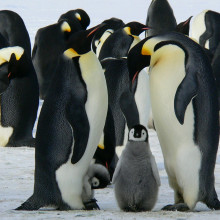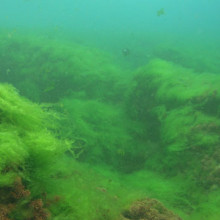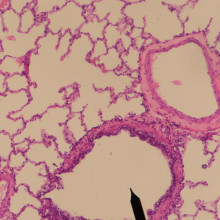We find out why size matters in bird beaks, how plant roots cope with competition, and what astronomers can learn about neutrinos in this NewsFlash. Plus, building lungs in the lab!
In this episode

00:10 - Smaller beaks for colder climates
Smaller beaks for colder climates
Birds living in colder climates evolved smaller beaks than their fair-weather cousins to help keep them warmer, a new study shows.
Led by Matt Symonds from the University of Melbourne in Australia, the study published in American Naturalist looked at over two hundred bird species from across the globe - including African barbets and tinkerbirds, Australian parrots, Canadian gamebirds, penguins, and terns - to see how their beak sizes varied with the temperature regime of their native habitat.
We already know from thermal imaging studies that birds like toucans and geese can lose a lot of their body heat through their big beaks.
Now Symonds and the team have robust evidence that birds living in colder environments, whether that's towards the poles or up a mountain, tend to have smaller beaks.
It could be that birds in warmer climates have evolved bills to shed heat, but the authors think it's more likely that cold temperature is a constraint on the size of birds' beaks. A big beak radiating heat would be too much of a liability in a cold climate, no matter what other advantages might come with it, like communication or attracting mates.
This is the first in-depth study that backs up a 133 year old theory, called Allen's rule, which predicts that warm-blooded animals from colder parts of the world will evolve smaller appendages including ears, tails, and limbs.
The team didn't find such a strong relationship between bird leg length and temperature, suggesting that beaks are more important as a source of heat loss, and consequently the need to regulate body temperature has been an important factor in shaping the evolution of bird beaks.

03:01 - Plants can make decisions
Plants can make decisions
Scientists have discovered that plants are far less passive than we first thought and can integrate information to help them make decisions. University of Alberta researcher James Cahill and his colleagues made the discovery by growing specimens of a Chinese flower called Abutilon theophrasti (also called the Velvetleaf or China Jute) either in isolation, or together in the same pot, and then following where the roots went.

In a further twist, the team also varied where the nutrients were in the soil in the pot; in some cases the nutrients were evenly dispersed throughout, in other cases closer to one plant than another, or in the centre between two competing plants. In each case, after the plants had matured, the researchers chopped the leaves off and injected coloured dyes down the stems to mark up the tissue so that the root systems from each plant could be distinguished and measured. Plants growing in isolation on soil with homogeneous nutrient supplies produce extensive root balls, as do plants growing on soils where the nutrients are eccentrically placed, whilst plants growing in competition on soils with homogeneously-distributed nutrients avoid each other like the plague and the roots never overlap.
But the real surprise came when the team tested what happens when the nutrients are placed between the two plant specimens. This time, it turns out, the plants will allow their roots to overlap each other, indicating that they are weighing up the costs and benefits of competing with their flower-bedfellow whilst simultaneously gaining access to a limited resource.
This level of integration and decision making had never previously been appreciated in plants, which appear a "hole" lot sharper than we first thought!

05:17 - Astronomers close in on the mass of elusive neutrino particles
Astronomers close in on the mass of elusive neutrino particles
Physicists are desperate to explain shortcomings in our understanding of the behaviour of fundamental particles; an announcement this week from astronomers remind us that the sky can tell us as much -- perhaps sometimes more -- about particles than experiments down here on Earth can.
The announcement focuses on neutrinos, which are pretty mysterious particles. They were predicted to exist by particle physicists as early as the 1930's, but not detected directly experimentally the late 1950's. Even today, performing experiments on neutrinos is immensely difficult, because they can speed straight through solid matter without ever leaving a trace they were there. Even more peculiar, according to the so-called standard model of particle physics, neutrinos should have no mass whatsoever. But from observations of the neutrinos naturally produced in the Sun, astronomers confirmed in the late 90's that neutrinos must, in reality, actually have mass, contrary to the standard model of particle physics. There was no other way to make sense of the neutrinos detected arriving from the Sun.
In fact it's been increasingly realized that astronomical scales are an excellent place to detect the effects of the mass associated with neutrinos. Because they have effects on the early Universe, neutrinos leave tell-tale signs in the distribution of matter in the present-day cosmos. Work from University College London published this week in Physical Review Letters has used a new survey, known as MegaZ, of the positions of 700,000 galaxies, in combination with existing astronomical data, to put a tight upper limit on the possible mass of neutrinos. The limit says that the mass must be smaller than 0.3 of an electron volt -- that's a fraction of a billionth of a single atom. That level of *upper* limit is actually particularly significant because it's getting close to a *lower* limit on the mass set by other observations (like those neutrinos which arrive from the Sun). We're squeezing the result between a lower and upper bound; sooner-or-later we'll have to get a measurement of the actual mass.
To put it in context, the new upper limit's a factor of 2 tighter than the limits set by previous galaxy surveys. But, on the other hand, it's not actually much tighter than the limit set by studies of another tracer of matter in the Universe, the so-called Lyman Alpha forest. The nice thing about the new work is that some of the assumptions made in doing the calculation from galaxies are rather different from the assumptions made in doing the calculation from the Lyman alpha forest. So that both of these methods are pointing to the same limit means we can be increasingly confident neutrino masses are smaller than that 0.3 electron volt. That said, there are still assumptions made in the way these calculations are done, so there's some possibility the limits will have to be revised as new and more constraining surveys come along.
But overall it's exciting that astronomical observations can tell us more about a tiny, elusive particle than direct experiments can here on Earth.

07:52 - Ocean Algae Mystery Solved
Ocean Algae Mystery Solved
Scientists have taken steps towards solving a thirty-year oceanographic puzzle, with the discovery that microscopic algae living in mid-ocean areas must be getting essential nutrients from as deep as 250 metres beneath the waves. But exactly how they are getting hold of nitrates from deep down remains a tantalizing mystery.
The study published in Nature, led by Ken Johnson from the Monterey Bay Aquarium Research Institute, provides some answers to the important question of how algae manage to flourish in areas of clear blue ocean where there are virtually no nutrients.
The team deployed a robotic drifter called an Apex float into waters off Hawaii. For two years it automatically bobbed up and down in the water column, between the surface and 1000 meters down, measuring oxygen and nitrate levels as it went.
They found that from January to October, concentrations of oxygen in the upper 100 metres gradually increased. At the same time, the concentration of nitrate in deeper waters, from 100 to 250 metres, decreased. This suggests that algae in shallow water - where there is enough sunlight - are photosynthesising and producing oxygen, while somehow grabbing nutrients from deeper, darker waters. But how they do this, is not clear.
Johnson and the team suggest there could be dormant microalgae living in deeper waters that are occasionally stirred up into shallower waters by swirling eddie currents. Reaching around 70 metres they would mop up nutrients then perhaps continue on up into the sunlit shallows under their own steam - some algae can swim using tiny whip-like hairs and others can actively control their buoyancy, and choose whether to sink or float.
The next step will be to deploy Appex floats in other parts of the ocean to see what's going on elsewhere including the Southern Ocean where nitrate supplies and algae growth are both much higher than in mid-ocean areas.
Understanding more about how these mid-ocean algae grow is vitally important because they account for a fifth of the carbon dioxide uptake in all plants and algae on the planet, so they play a vital role in regulating global climate.

10:34 - Growing an artificial lung
Growing an artificial lung
Dr. Thomas Petersen, Yale University
Chris - Also in the news this week, researchers at Yale University in America have come one step closer to building a functional lung in the laboratory. The team stripped cells off the lung of a rat which left behind a connective tissue scaffolding which they then repopulated with new cells, and this newly formed lung successfully exchanged oxygen and carbon dioxide for a short time after it was transplanted into another recipient rat. And this offers hope that we might be able to build replacement lung tissue for people in the future. Well joining us to tell us a bit more about how he made this happen is one of the researchers, Dr. Thomas Petersen who is a Post Doctoral Associate in Biomedical Engineering at Yale.
Hello, Thomas. Thank you for joining us on the Naked Scientists. Tell us first of all - I gave a very brief summary and overview there - how did you actually do this work?
Thomas - Well you gave a very excellent summary. We start with a normal lung of a rat and treat it with a chemical solution to remove all the cells and this gives us this three-dimensional scaffold or skeleton of a lung, and that's a very important part because the 3D structure of a lung is quite complex and something that we couldn't easily make in the laboratory if we wanted to. So we can't make an artificial material that is in a shape of a lung. This scaffold can then be seeded with cells. A variety of cell types we used - both blood vessels cells and airway cells, and then we cultured this growing tissue in the lab for about a week, after which we can take it out and study it in a variety of ways, and we can also transplant it into rats as you mentioned.
Chris - And once you've got the scaffolding, how did the cells that you transplant onto that scaffolding know where to go, and what sorts of cells to turn into?
Thomas - That's a very good question. So there are two things that we did to try and help the cells go to the right places. The first - at a very high level - is we put them into the right compartments. So in the lung, you pretty much have two areas. You have the airway compartment and the blood vessel compartment, and so at a very high level, we just put the blood vessel cells into the blood vessels and the airway cells into the airways. The second thing we did to try and help this was during this one week of growth in the lab, we provided stimuli to the lung, so the lung was being breathed, similar to the way a patient is breathed on a ventilator, and we also pumped nutrients; a nutrient solution, through the blood vessels of the lung. So these two stimuli helped to encourage the cells to grow in more normal lung patterns. But certainly, we don't fully know why all of the cells seem to go to the right places, and that's something that we're interested in trying to look into further, going forward.

Chris - Because one of the interesting things about lungs is that it's not just a bunch of blood vessels and a bunch of airway cells. There are individual different types of cells in both structures but certainly in the airways, there are things like cells that make the surfactant, the chemical that makes the water lose its surface tension so the airways don't collapse for example. Those cells appeared and populated the airways in the right numbers in your tests. Do you think there are signals coming off of that underlying scaffold that direct the cells to turn into certain specialised forms?
Thomas - Yes, absolutely. Our most likely scenario is that there are cues left behind on this empty three-dimensional scaffold that are helping to direct the right cells to adhere to the right spots on the lung. There are other possibilities that we're interested in looking into, but that's really the most likely scenario, that there are some cellular signals that are staying behind on the scaffold.
Chris - And you were able to take this regrown lung which took what - a week or so to regrow? And then put that into a recipient animal.
Thomas - That's correct. So we performed left lung transplants on several animals. This is only short-term transplants for up to 2 hours, but they did work quite well. There were no large leaks of air or blood, and the primary function we're looking at evaluating is, as you said earlier, gas exchange. So whether the lungs can oxygenate the blood that's flowing through them and whether they can remove carbon dioxide out of the blood, and they performed very well on both of those aspects.
Chris - Why did you only go for 2 hours? Was that all that you had permission to do, or was it that the lungs at some point failed beyond that point, and there's more work to do?
Thomas - Right. Well it's a combination of both of those. We do have limitations on what we can do in the animals and 2 hours was our objective and the lungs were still doing fine. They were still breathing, there were still blood flowing through them after 2 hours, but certainly, we wouldn't right now expect that they would have functioned as well for a day or maybe even several hours. After 2 hours in some of the lungs, we were able to see small blood clots forming in some areas, and certainly, that would've gotten worse over time, and that's one of the things we need to work on in this going forward is, ensuring that no blood clots form in the engineered lung.
Chris - Now one obvious direct application of this is to say, well, if we do lung transplants on humans, whilst this does save lives, the long term prognosis is still quite poor because the immune system moves in and causes damage, infections move in and cause damage, and therefore, it's not a perfect solution. If we could take a lung scaffold and populate it with the person's own cells, so we didn't have to reduce the activity of the immune system, this would presumably be a very big short term goal for work of this type.
Thomas - Right. I would still call that a long term goal. We do obviously want to transition this work into human tissue, and the way to do that would be to start with a human or similarly sized lung scaffold and then obtain cells from a given patient. And they are having advances lately involving stem cell work, involving adult-derived stem cells that we could possibly use to repopulate this human lung scaffold, and that would avoid rejection in a transplant patient. I would estimate it would still take say, 20 years before we can grow a fully functional human lung in the laboratory.
Chris - Although I guess the ultimate goal and the reason I said a shorter term goal versus a longer term one is that you really want to be able to produce a complete lung de novo by using say, microfabrication techniques or something to lay down a scaffold so you don't have to borrow someone else's.
Thomas - Yes. Well there's a few ways in which you could get the scaffold to begin with. The first option would be a human lung that is not suitable for transplant, and there are quite a few available lungs that are just simply not good enough to use for transplant. It's also possible to potentially use the lung of a primate or even a pig. The molecules that make up this lung scaffold are highly conserved or highly similar across these species, and it would be highly unlikely that they would be recognised by the body as foreign - meaning they would not then be rejected.










Comments
Add a comment